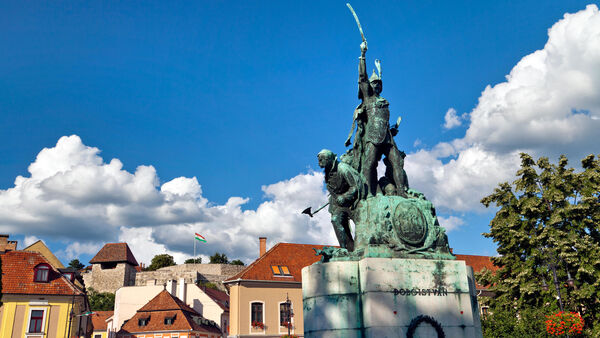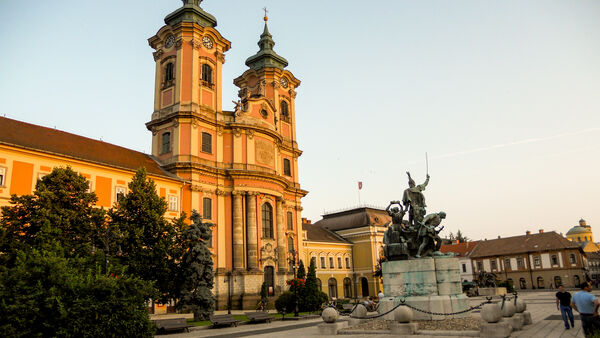Enchanting Eger



By Rick Steves and Cameron Hewitt
Eger, in northern Hungary, has a fascinating history, a handful of fun sights, nearby vineyards, and an unassuming charm — but few crowds. Just two hours by train from Budapest, Eger makes for an ideal taste of small-town Hungary. Wander the peaceful streets as residents go about their routines amidst lovely Baroque buildings, watched over by Hungary's most important castle.
While unspoiled, Eger is not unknown. It's famed as the town that, against all odds, successfully held off the Turkish advance into Europe. Working their way up the Balkan Peninsula, 60,000 Turks arrived in Eger on September 11, 1552. Some 2,000 Eger residents, fighting from within their castle's protective walls, held the line against the advancing invaders. After a 38-day siege, the Turks retreated in defeat. Sadly, they returned in 1599 and, this time, succeeded in conquering the castle. The Turks sacked the town and controlled the region for close to a century. Evidence of that time remains; look for the 130-foot-tall minaret and the traditional Turkish bath. (The influential Battle of Vienna in 1683 succeeded in eliminating the Turkish threat entirely.) But of course, Hungary cherishes Eger's victory, not its defeat, and this castle is the focus of patriotic field trips for students throughout the country.
A perfect day in Eger begins with a browse through the colorful produce market. Then head to the college building called the Lyceum to visit its library and astronomy museum, and climb up to the thrillingly low-tech camera obscura. Have a memorable lunch on Dobó Square, then hike up to the castle for views all over town. In the late afternoon, unwind at a thermal bath — either in Eger or the countryside. Round out your day with dinner on the square or a visit to Eger's touristy wine caves in the Sirens' Valley.
The heart of Eger is Dobó Square, named for István Dobó, who commanded the town's forces in the siege of 1552. Dominating the square are the twin towers of the exquisitely photogenic Minorite Church, often said to be the most beautiful Baroque church in Hungary (though a bit shabby inside). Nearby is the indoor market, offering a taste of local life.
Eger Castle, site of the 16th-century siege, hovers above. The castle grounds feature several small museums, including a history museum, archery exhibit (where you can pay to test your skill with old-fashioned bows), dungeon, and a waxworks with eerily realistic representations of the heroes and villains from the siege of Eger. But the most rewarding way to visit the castle is to simply wander the grounds and enjoy the vistas from the ramparts.
Spring forward to several centuries with a visit to the Lyceum. In the mid-18th century, Bishop Károly Eszterházy wanted a university in Eger, but Habsburg Empress Maria Theresa refused to allow it. Instead, Eszterházy built this elegant Baroque teacher-training college, which still trains local teachers. The college houses two sights worth a look: a glorious Baroque library (60,000 books in over 30 languages shelved oddly — according to size, rather than topic — under a frescoed ceiling), and the "Magic Tower," with some scientific exhibits and a working 18th-century camera obscura. After you enter a dark room and gather around a big bowl-like canvas, the guide flies you around the streets of Eger.
Plunge back into the 21st century at the city's indoor/outdoor thermal bath, featuring cascades, jets, bubbly fun, and seven different-temperature pools. Settle in and soak up Eger's charms.
Perhaps most of all, Eger is known for its wine. When the Turkish invaders first occupied Eger, residents moved into the valley next door, living in caves dug into the hillside. Eventually the Egerites moved back to town, and the caves became wine cellars. There are more than 300 such caves in the valley to the southwest of Eger, several of which are open for visitors. The best selection of these caves is in the Sirens' Valley, on the outskirts of town. It's a fun scene — vintners showing off their latest vintage, with food, picnic tables, and tipsy tourists spilling out into the street. Enjoy some in the company of a local vintner, glad to have discovered the Hungarian Back Door gem of Eger.
Cameron Hewitt is the co-author of the Rick Steves Budapest guidebook.

